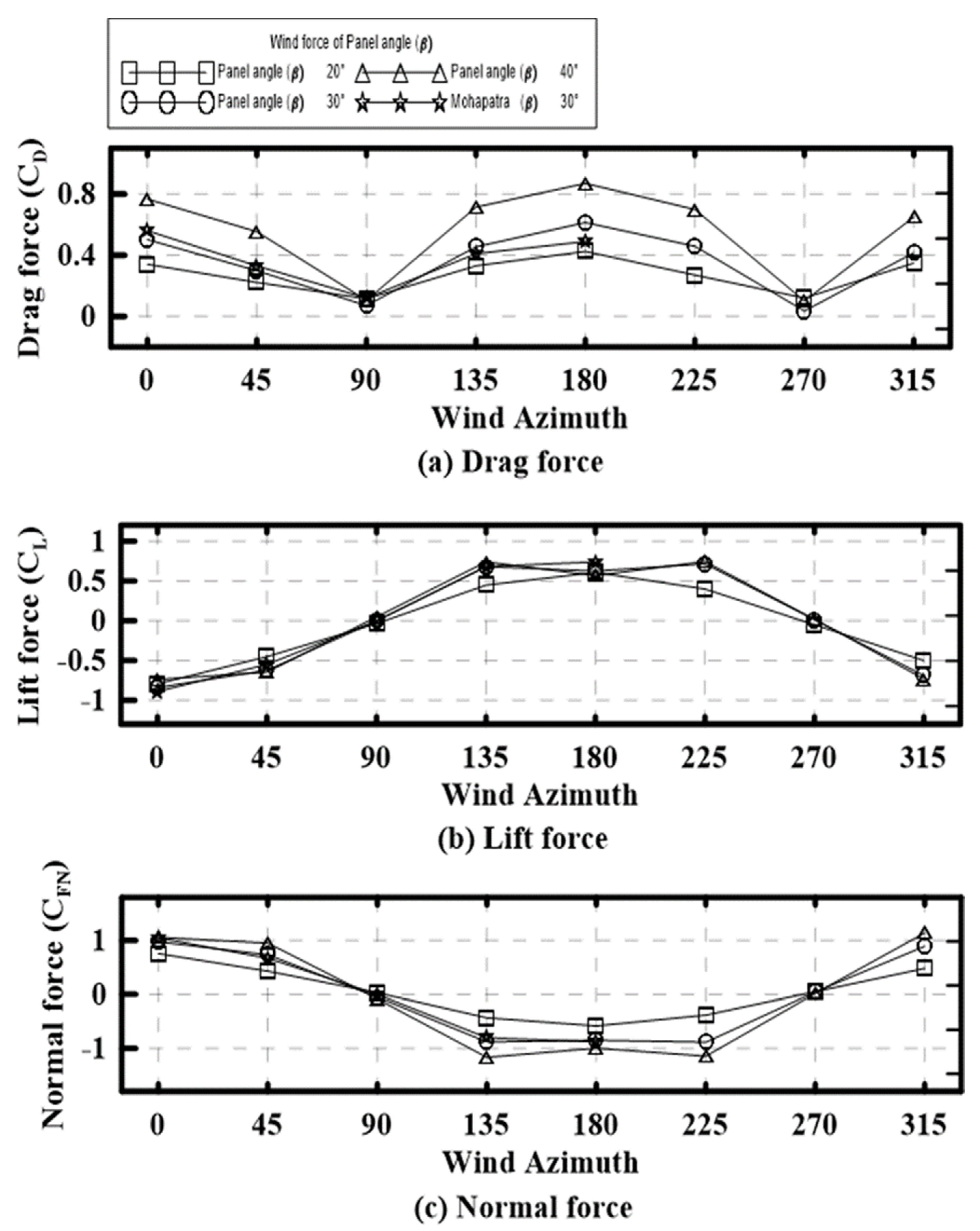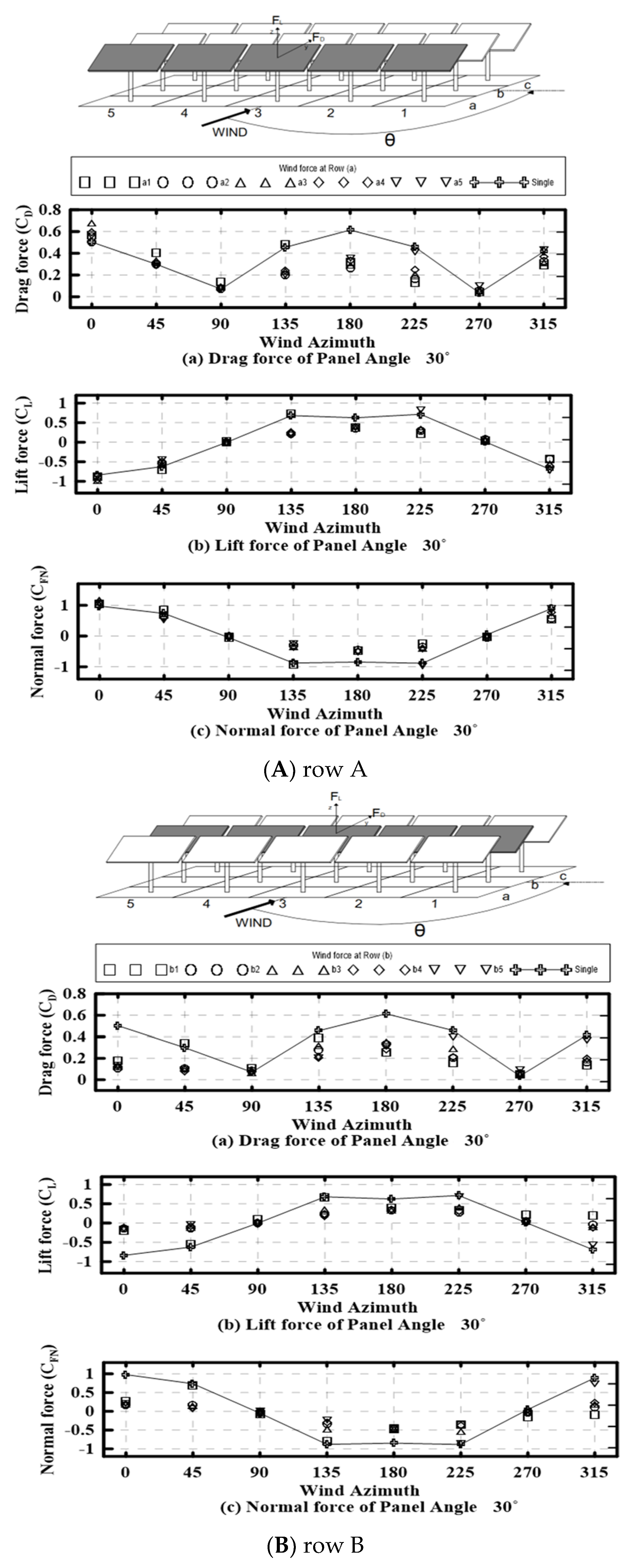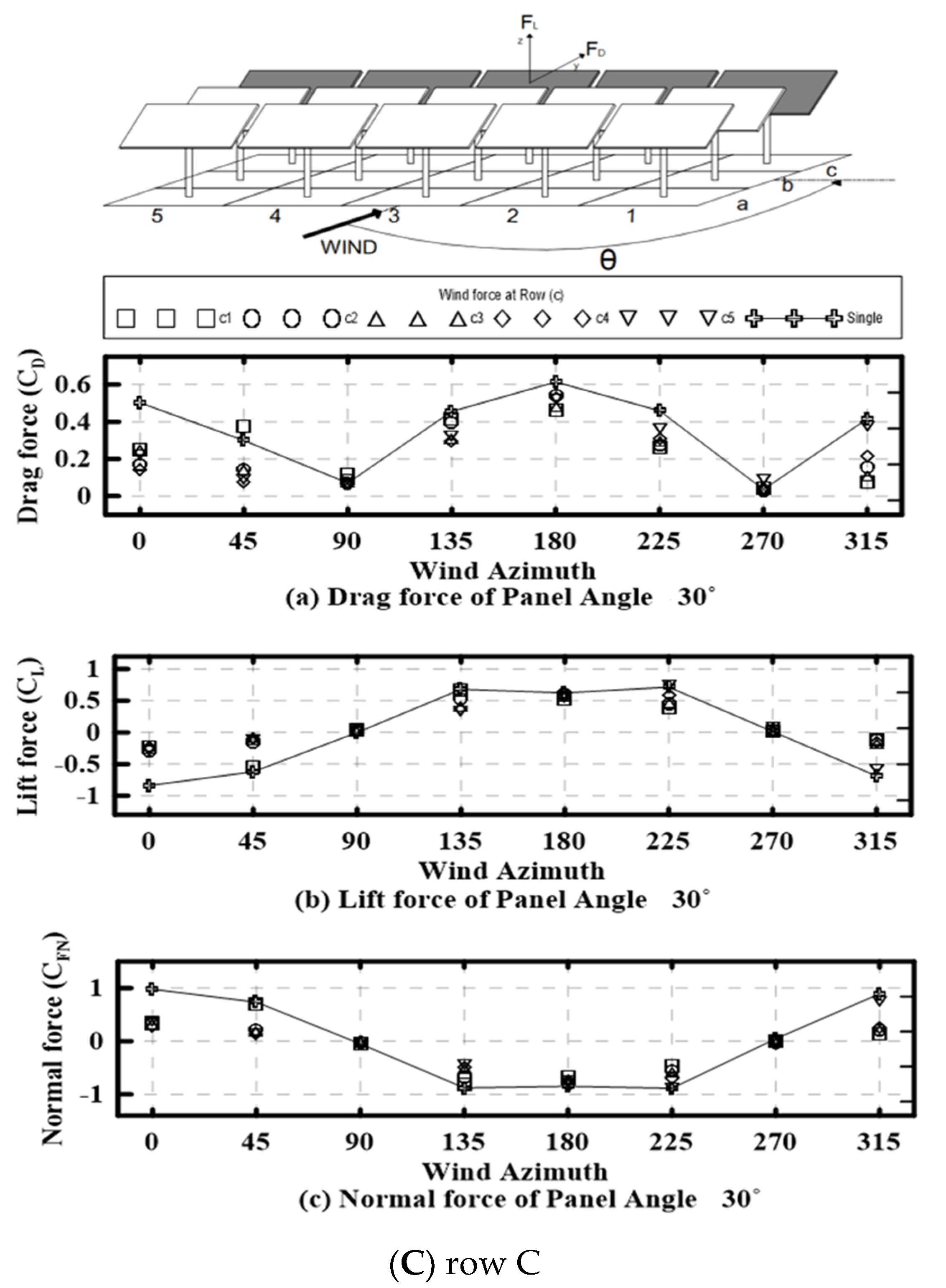Wind Coefficient Distribution of Arranged Ground Photovoltaic Panels
Abstract
:1. Introduction
2. Experiment and Methods
2.1. Experimental Model
2.2. Wind Tunnel Experiment
3. Results
3.1. Wind Power Coefficients
3.2. Single Panel (Case I)
3.2.1. Surface Wind Speed Distribution
3.2.2. Gradient Angle Change of Photovoltaic Panel
3.3. Array Panel (Case 2)
3.4. Distribution of Wind Coefficients in Solar Arrays
3.4.1. Wind Factor Distribution Plot for Wind Flow
3.4.2. Distribution of Wind Coefficients for Headwinds
4. Conclusions
- (1)
- In the case of drag coefficients and lift coefficients, the distribution was almost the same regardless of air flows, and it was found that the drag coefficients were highly influenced by air flows.
- (2)
- The change in vertical force, which is the wind factor acting on the vertical surface of a single solar panel, was not affected by surface roughness. In addition, wind direction changes were distributed with the largest vertical force coefficients in the 0° forward wind direction relative to the front of the solar panel and in the 345° backward wind direction and 135° and 225° rear diagonal directions.
- (3)
- In addition, after investigating the change in wind coefficients with changes in solar panel inclination, drag coefficients were the highest at 40° sloping angles on the panel, followed by 30° and 20° sloping angles. However, the lift coefficient and vertical force coefficient were not significantly affected by the tilt angle of the panel.
- (4)
- The drag coefficient increased in the order 40° > 30° > 20° of the slope angle of the panel (β) from the change in the wind coefficient according to the change in the slope angle of solar panel (β). However, the coefficients of lift and vertical force were not significantly affected by the slope angle of the panel.
- (5)
- The wind factor of the arrayed panel was affected by the wind direction angle and panel position. The array, as a whole, exhibited a lower coefficient distribution than in the single-panel experiment, except for row a, which was closest to the wind direction angle of 0°. In the case of panels placed inside, the surrounding panels reduced the wind speed, indicating that the wind factor value was distributed lower than in the single-panel experiment. This is attributed to the lack of significant delamination at the end of the panel because of the surrounding array compared with the single-panel experiment.
- (6)
- The wind factor acting on the solar panels placed in the array was larger than that in the headwind. The effect of the fence on the reduction of wind coefficients owing to the location of solar panels was greater than that of the headwinds. In the normal force, up to 60% or more of the backwind was larger, indicating that the back of the panel was affected more than the front.
Author Contributions
Funding
Institutional Review Board Statement
Informed Consent Statement
Data Availability Statement
Acknowledgments
Conflicts of Interest
References
- Radu, A.; Axinte, E.; Theohari, C. Steady wind pressures on solar collectors on flat-roofed buildings. J. Wind Eng. Ind. Aerodyn. 1986, 23, 249–258. [Google Scholar] [CrossRef]
- Miller, R.D.; Zimmerman, D.K. Wind Loads on Flat Plate Photovoltaic Array Fields; Boeing Engineering and Construction Co.: Seattle, WA, USA, 1981. [Google Scholar]
- Bienkiewicz, B.; Endo, M. Wind considerations for loose-laid and photovoltaic roofing systems. In Structures Congress 2009: Don’t Mess with Structural Engineers: Expanding Our Role; 2009 American Society of Civil Engineers: Austin, TX, USA, 2009; pp. 1–10. [Google Scholar]
- Bronkhorst, A.; Franke, J.; Geurts, C.; van Bentum, C.; Grepinet, F. Wind tunnel and CFD modelling of wind pressures on solar energy systems on flat roofs. In Proceedings of the 5th International Symposium on Computational Wind Engineering (CWE2010), Chapel Hill, NC, USA, 23–27 January 2010. [Google Scholar]
- Aly, A.M.; Bitsuamlak, G. Wind-induced pressures on solar panels mounted on residential homes. J. Archit. Eng. 2014, 20, 04013003. [Google Scholar] [CrossRef]
- Banks, D. The role of corner vortices in dictating peak wind loads on tilted flat solar panels mounted on large, flat roofs. J. Wind Eng. Ind. Aerodyn. 2013, 123, 192–201. [Google Scholar] [CrossRef]
- Aly, A.M.; Bitsuamlak, G. Aerodynamic loads on solar panels. In Structures Congress 2013: Bridging Your Passion with Your Profession; American Society of Civil Engineers: Pittsburgh, PA, USA, 2013; pp. 1555–1564. [Google Scholar]
- Geurts, C.; Blackmore, P. Wind loads on stand-off photovoltaic systems on pitched roofs. J. Wind Eng. Ind. Aerodyn. 2013, 123, 239–249. [Google Scholar] [CrossRef]
- Stathopoulos, T.; Zisis, I.; Xypnitou, E. Wind loads on solar collectors: A review. In Structures Congress; 2013 American Society of Civil Engineers: Chicago, IL, USA, 2012; pp. 1169–1179. [Google Scholar]
- Stathopoulos, T.; Xypnitou, E.; Zisis, I. Wind Loads on Rooftop Solar Panel Systems: A Contribution to NBCC 2015. In Proceeding of the 7th Workshop on Regional Harmonization of Wind Loading and Wind Environmental Specifications in Asia-Pacific Econo-mies, Hanoi, Vietnam, 12–13 November 2012. [Google Scholar]
- Mohapatra, S. Wind Tunnel Investigation of Wind Load on a Ground Mounted Photovoltaic Tracker. Master’s Thesis, Colorado State University, Fort Collins, CO, USA, 2011. [Google Scholar]
- Ikeda, H.; Kimura, K.; Kobayashi, T.; Kato, K.; Kubo, Y.; Ikeda, K. A study on the effects of wind direction on the wind force coefficient of solar panels arranged in rows for a solar panel power plant. J. Struct. Eng. 2012, 58, 559–566. [Google Scholar]
- Shademan, M.; Barron, R.M.; Balachandar, R. Nnsteady wind loading of solar panels in arrayed configuration. In Proceedings of the Canadian Society for Mechanical Engineering International Congress 2014, CSME International Congress 2014, Toronto, ON, Canada, 1–4 June 2014. [Google Scholar]
- Abiola-Ogedengbe, A.; Hangan, H.; Siddiqui, K. Experimental investigation of wind effects on a standalone photovoltaic (PV) module. Renew. Energy 2015, 78, 657–665. [Google Scholar] [CrossRef]
- Ikeda, H.; Matsuda, K.; Kato, K.; Ikeda, K. Estimation and refinement of wind-force coefficient acting on a photovoltaic array on the ground. J. JSCE 2015, 3, 45–59. [Google Scholar] [CrossRef] [Green Version]
- Ginger, J.; Payne, M.; Stark, G.; Sumant, B.; Leitch, C. Investigation on Wind Loads Applied to Solar Panels Mounted on Roofs; Report No. TS 821, Cyclone Testing Station, School of Engineering and Physical Sciences, James Cook University, reviewed by J. Holmes, December 22, Townsville, Australia; Cyclone Testing Station: Townsville, Australia, 2011. [Google Scholar]
- You, K.P.; Kim, Y.M.; You, J.Y. Characteristics of Wind Pressure Distributions Acting on Solar Collector Plate. J. Korean Assoc. Spat. Struct. 2013, 13, 67–73. [Google Scholar] [CrossRef]
- Stenabaugh, S.E.; Iida, Y.; Kopp, G.A.; Karava, P. Wind loads on photovoltaic arrays mounted parallel to sloped roofs on low-rise buildings. J. Wind Eng. Ind. Aerodyn. 2015, 139, 16–26. [Google Scholar] [CrossRef]
- Trejos-Grisales, L.A.; Bastidas-Rodríguez, J.D.; Ramos-Paja, C.A. Mathematical Model for Regular and Irregular PV Arrays with Improved Calculation Speed. Sustainability 2020, 12, 10684. [Google Scholar] [CrossRef]
- Gimeno-Sales, F.J.; Orts-Grau, S.; Escribá-Aparisi, A.; González-Altozano, P.; Balbastre-Peralta, I.; Martínez-Márquez, C.I.; Gasque, M.; Seguí-Chilet, S. PV Monitoring System for a Water Pumping Scheme with a Lithium-Ion Battery Using Free Open-Source Software and IoT Technologies. Sustainability 2020, 12, 10651. [Google Scholar] [CrossRef]
- Aly, A.M. On the evaluation of wind loads on solar panels: The scale issue. Sol. Energy 2016, 135, 423–434. [Google Scholar] [CrossRef]
- Shademan, R.M.; Balachandar, R.M. Barron, Detached eddy simulation of flow past an isolated inclined solar panel. J. Fluids Struct. 2014, 50, 217–230. [Google Scholar] [CrossRef] [Green Version]
- Shademan, M.; Barron, R.M.; Balachandar, R.; Hangan, H. Numerical simulation of wind loading on ground-mounted solar panels at different flow configurations. Can. J. Civ. Eng. 2014, 41, 728–738. [Google Scholar] [CrossRef]
- Stathopoulos, T.; Zisis, I.; Xypnitou, E. Local and overall wind pressure and force coefficients for solar panels. J. Wind Eng. Ind. Aerodyn. 2014, 125, 195–206. [Google Scholar] [CrossRef]
- López, A.; Parnás, V.E.; Cataldo, J. Wind tunnel experiments on ground-mounted photovoltaic solar panels. Rev. Ing. de Construcción 2019, 34, 15–24. [Google Scholar] [CrossRef] [Green Version]














| CASE | 1 (Single) | 2 (Array) |
|---|---|---|
| Size of panel (W × L × H) | 325 × 160 × 270 | - |
| Size of array (W’ × L’ × H’) | - | 1705 × 700 × 270 |
| Classification | α = 0.15 |
|---|---|
| Model scale | 1/25 |
| Height (m) | 3.5 |
| Basic wind velocity (m/s) | 26 |
| Design wind velocity (m/s) | 22.28 |
| Experiment wind velocity (m/s) | 5 |
| Velocity scale | 4.46 |
| Time scale | 5.61 |
| Sampling frequency | 200 Hz (0.005 s) |
| Measurement time (s) | 110 |
| Real time (min) | 10.29 |
| Ensemble averaging | Five times (number 2048) |
| Lowpass filter | 100 Hz |
Publisher’s Note: MDPI stays neutral with regard to jurisdictional claims in published maps and institutional affiliations. |
© 2021 by the authors. Licensee MDPI, Basel, Switzerland. This article is an open access article distributed under the terms and conditions of the Creative Commons Attribution (CC BY) license (https://creativecommons.org/licenses/by/4.0/).
Share and Cite
You, J.; Lim, M.; You, K.; Lee, C. Wind Coefficient Distribution of Arranged Ground Photovoltaic Panels. Sustainability 2021, 13, 3944. https://doi.org/10.3390/su13073944
You J, Lim M, You K, Lee C. Wind Coefficient Distribution of Arranged Ground Photovoltaic Panels. Sustainability. 2021; 13(7):3944. https://doi.org/10.3390/su13073944
Chicago/Turabian StyleYou, Jangyoul, Myungkwan Lim, Kipyo You, and Changhee Lee. 2021. "Wind Coefficient Distribution of Arranged Ground Photovoltaic Panels" Sustainability 13, no. 7: 3944. https://doi.org/10.3390/su13073944
APA StyleYou, J., Lim, M., You, K., & Lee, C. (2021). Wind Coefficient Distribution of Arranged Ground Photovoltaic Panels. Sustainability, 13(7), 3944. https://doi.org/10.3390/su13073944







